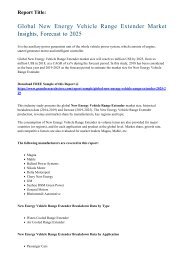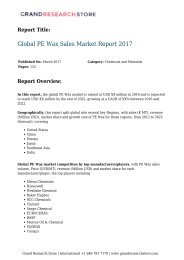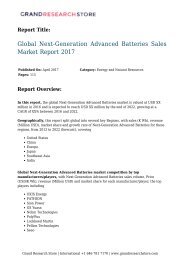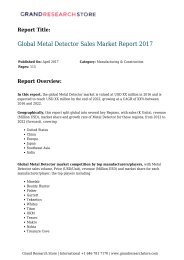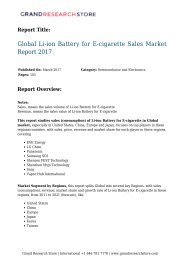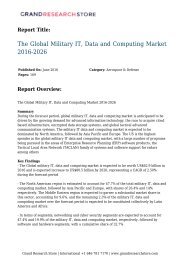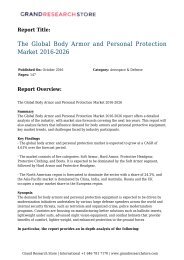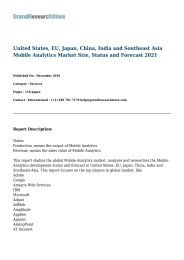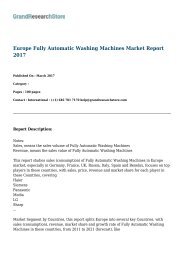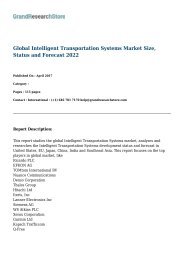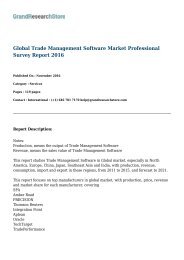Software Defined Radio Market - Global Forecast to 2021
The software defined radio market is estimated to be USD 16.24 billion in 2016, and is projected to reach USD 29.12 billion by 2021, at a CAGR of 12.39% between 2016 and 2021. Demand for advanced communication systems to replace legacy equipment, network interoperability, compatibility of devices with future standards, universal connectivity, and reduced cost of end products and services are some the major factors driving the software defined radio market. However, high development cost and integration issues have been restraining the market growth.
The software defined radio market is estimated to be USD 16.24 billion in 2016, and is projected to reach USD 29.12 billion by 2021, at a CAGR of 12.39% between 2016 and 2021. Demand for advanced communication systems to replace legacy equipment, network interoperability, compatibility of devices with future standards, universal connectivity, and reduced cost of end products and services are some the major factors driving the software defined radio market. However, high development cost and integration issues have been restraining the market growth.
Create successful ePaper yourself
Turn your PDF publications into a flip-book with our unique Google optimized e-Paper software.
<strong>Software</strong> <strong>Defined</strong> <strong>Radio</strong> <strong>Market</strong> by Application (Defense,<br />
Commercial, Homeland Security), Component (<strong>Software</strong>,<br />
Transmitter, Receiver), End User (Military, Transportation),<br />
Type (JTRS, Cognitive/Intelligent <strong>Radio</strong>, TETRA) - <strong>Global</strong><br />
<strong>Forecast</strong> <strong>to</strong> <strong>2021</strong><br />
Published On : November 2016<br />
Category : Aerospace & Defence<br />
Pages : 182 pages<br />
Contact : International : (+1) 646 781 7170 help@grandresearchs<strong>to</strong>re.com<br />
Report Description:<br />
“The software defined radio market is projected <strong>to</strong> grow at a CAGR of 12.39%”<br />
The software defined radio market is estimated <strong>to</strong> be USD 16.24 billion in 2016, and is<br />
projected <strong>to</strong> reach USD 29.12 billion by <strong>2021</strong>, at a CAGR of 12.39% between 2016 and <strong>2021</strong>.<br />
Demand for advanced communication systems <strong>to</strong> replace legacy equipment, network<br />
interoperability, compatibility of devices with future standards, universal connectivity, and<br />
reduced cost of end products and services are some the major fac<strong>to</strong>rs driving the software<br />
defined radio market. However, high development cost and integration issues have been<br />
restraining the market growth.<br />
“Defense segment <strong>to</strong> account for the dominant share in the software defined radio market”<br />
The defense segment dominates the software defined radio market. The global defense<br />
forces are investing heavily in new technologies <strong>to</strong> modernize their forces and determine the<br />
best technology that offers exceptional performance in the long run with lesser development<br />
cost.<br />
“G7 Nations accounted for a dominant share, whereas BRICS is the fastest-growing regional<br />
market for software defined radio”
G7 Nations dominates the software defined radio market. The market in the region is mainly<br />
driven by the increasing demand for SDR across various sec<strong>to</strong>rs, such as military, public<br />
safety, and commercial. BRICS is expected <strong>to</strong> exhibit the highest growth rate in the software<br />
defined radio market during the forecast period. This growth can be attributed <strong>to</strong> the<br />
growing global demand for military equipment, which is boosting the investments related <strong>to</strong><br />
the re<strong>to</strong>oling of the existing processes and expanding the technical capacities of the SDR<br />
market, particularly in Asia.<br />
Break-up of profile of primary participants for this report:<br />
• By Company Type: Tier 1 – 35%, Tier 2 – 45% and Tier 3 – 20%<br />
• By Designation: C level – 35%, Direc<strong>to</strong>r level – 25%, Others – 40%<br />
• By Region: North America - 45%, Europe – 20%, Asia-Pacific – 30%, RoW – 5%<br />
Key players profiled in the software defined radio market report include Northrop Grumman<br />
Corporation (U.S.), BAE Systems Plc. (U.K.), Elbit Systems Ltd (Israel), Thales Group<br />
(France), and L-3 Communications Holdings, Inc. (U.S.), among others.<br />
Research Coverage:<br />
The study segments the software defined radio market on the basis of application (defense,<br />
commercial, and homeland security), component (transmitter, receiver, and software), type<br />
(JTRS, cognitive/intelligent radio, TETRA), end user (military, telecommunication,<br />
transportation) and map these segments and subsegments across major regions worldwide,<br />
namely, G7 Nations, BRICS, and RoW (Rest of the World). The report provides in-depth<br />
market intelligence regarding market dynamics and major fac<strong>to</strong>rs that influence the growth<br />
of the global software defined radio market (drivers, restraints, opportunities, and industryspecific<br />
challenges), along with analyzing micromarkets with respect <strong>to</strong> individual growth<br />
trends, future prospects, and their contribution <strong>to</strong> the software defined radio market.<br />
Reasons <strong>to</strong> buy this report:<br />
From an insight perspective, this research report has focused on various levels of<br />
analysis—industry analysis (industry trends), market share analysis of <strong>to</strong>p players, supply<br />
chain analysis, and company profiles, which <strong>to</strong>gether comprise and discuss the basic views<br />
on the competitive landscape; emerging and high-growth segments of the software defined<br />
radio market; high-growth regions; and market drivers, restraints, and opportunities.<br />
The report provides insights on the following pointers:<br />
• <strong>Market</strong> Penetration: Comprehensive information on software defined radio offered by the<br />
<strong>to</strong>p players in the global software defined radio market<br />
• Product Development/Innovation: Detailed insights on upcoming technologies, research &<br />
development activities, and new product launches in the software defined radio market<br />
• <strong>Market</strong> Development: Comprehensive information about lucrative emerging markets – the<br />
report analyzes the markets for software defined radio across regions
• <strong>Market</strong> Diversification: Exhaustive information about new products, untapped<br />
geographies, recent developments, and investments in the global software defined radio<br />
market<br />
• Competitive Assessment: In-depth assessment of market shares, strategies, products, and<br />
manufacturing capabilities of the leading players in the global SDR market<br />
Table of contents:<br />
TABLE OF CONTENTS<br />
1 INTRODUCTION 18<br />
1.1 OBJECTIVES OF THE STUDY 18<br />
1.2 MARKET DEFINITION 18<br />
1.3 STUDY SCOPE 19<br />
1.3.1 MARKETS COVERED 19<br />
1.3.2 REGIONAL SCOPE 20<br />
1.3.3 YEARS CONSIDERED FOR THE STUDY 20<br />
1.4 CURRENCY & PRICING 21<br />
1.5 LIMITATIONS 21<br />
1.6 MARKET STAKEHOLDERS 22<br />
2 RESEARCH METHODOLOGY 23<br />
2.1 RESEARCH DATA 23<br />
2.1.1 SECONDARY DATA 25<br />
2.1.1.1 Key data from secondary sources 25<br />
2.1.2 PRIMARY DATA 26<br />
2.1.2.1 Key data from primary sources 26<br />
2.1.2.2 Breakdown of primaries 27<br />
2.2 FACTOR ANALYSIS 27<br />
2.2.1 INTRODUCTION 27<br />
2.2.2 DEMAND SIDE INDICATORS 28<br />
2.2.2.1 Increasing demand for cognitive radio 28<br />
2.2.2.2 Increasing demand for advanced communication systems 28<br />
2.2.2.3 Increased defense spending by developing economies 29<br />
2.2.3 SUPPLY SIDE INDICATORS 30<br />
2.2.3.1 Major U.S. defense contrac<strong>to</strong>rs in software defined radio 30<br />
2.3 MARKET SIZE ESTIMATION 30<br />
2.3.1 BOTTOM-UP APPROACH 31<br />
2.3.2 TOP-DOWN APPROACH 32<br />
2.4 MARKET BREAKDOWN & DATA TRIANGULATION 33
2.5 RESEARCH ASSUMPTIONS 34<br />
3 EXECUTIVE SUMMARY 35<br />
4 PREMIUM INSIGHTS 40<br />
4.1 ATTRACTIVE OPPORTUNITIES IN THE SOFTWARE DEFINED RADIO MARKET,<br />
2016-<strong>2021</strong> 40<br />
4.2 SOFTWARE DEFINED RADIO MARKET, BY APPLICATION 40<br />
4.3 SOFTWARE DEFINED RADIO MARKET, BY COMPONENT 41<br />
4.4 SOFTWARE DEFINED RADIO MARKET, BY END-USER 41<br />
4.5 SOFTWARE DEFINED RADIO MARKET, BY TYPE 42<br />
4.6 SOFTWARE DEFINED RADIO MARKET, BY REGION 42<br />
4.7 LIFE CYCLE ANALYSIS, BY REGION 43<br />
5 MARKET OVERVIEW 44<br />
5.1 INTRODUCTION 44<br />
5.2 KEY INDUSTRY INSIGHTS 45<br />
5.3 MARKET SEGMENTATION 46<br />
5.3.1 BY APPLICATION 46<br />
5.3.2 BY TYPE 46<br />
5.3.3 BY COMPONENT 47<br />
5.3.4 BY END-USER 47<br />
5.4 MARKET DYNAMICS 48<br />
5.4.1 DRIVERS 48<br />
5.4.1.1 Demand for advanced communication systems <strong>to</strong> replace legacy equipment 48<br />
5.4.1.2 Network interoperability 49<br />
5.4.1.3 Spectrum reuse 49<br />
5.4.1.4 Compatibility of devices with future standards 49<br />
5.4.1.5 Universal connectivity 50<br />
5.4.1.6 Reduced cost of end products and services 50<br />
5.4.2 RESTRAINTS 51<br />
5.4.2.1 High development cost 51<br />
5.4.2.2 Security concerns 51<br />
5.4.2.3 Integration issues 51<br />
5.4.2.4 Ensuring seamless connectivity in a limited bandwidth 51<br />
5.4.3 OPPORTUNITIES 52<br />
5.4.3.1 Use of commercial off-the-shelf (COTS) technology in software defined radio systems<br />
52<br />
5.4.3.2 Growing adoption in commercial applications 52<br />
5.4.3.3 New opportunities in the form of derived technologies such as cognitive radio 52<br />
5.4.3.4 Increasing demand in public safety and homeland security 53<br />
5.4.4 CHALLENGES 53<br />
5.4.4.1 Ensuring interoperability of disparate communication technologies 53<br />
5.4.4.2 Operation circumspection 53<br />
5.4.4.3 Dynamic communication standards 54<br />
5.4.4.4 Regula<strong>to</strong>ry hurdles 54
5.4.5 BURNING ISSUES 54<br />
5.4.5.1 Requirement of flexible network 54<br />
6 INDUSTRY TRENDS 55<br />
6.1 INTRODUCTION 55<br />
6.2 EMERGING TECHNOLOGY TRENDS 55<br />
6.2.1 COGNITIVE RADIO 56<br />
6.2.2 NEXT GENERATION IP 56<br />
6.2.3 NEAR FIELD COMMUNICATION 56<br />
6.2.4 MULTIBAND TACTICAL COMMUNICATION AMPLIFIERS 57<br />
6.3 INNOVATION AND PATENT REGISTRATION 57<br />
6.4 KEY TREND ANALYSIS 58<br />
7 SOFTWARE DEFINED RADIO MARKET, BY APPLICATION 59<br />
7.1 INTRODUCTION 60<br />
7.2 DEFENSE 61<br />
7.3 COMMERCIAL 62<br />
7.4 HOMELAND SECURITY 62<br />
8 SOFTWARE DEFINED RADIO MARKET, BY COMPONENT 64<br />
8.1 INTRODUCTION 65<br />
8.2 TRANSMITTER 66<br />
8.3 RECEIVER 67<br />
8.4 SOFTWARE 68<br />
9 SOFTWARE DEFINED RADIO MARKET, BY TYPE 69<br />
9.1 INTRODUCTION 70<br />
9.2 JOINT TACTICAL RADIO SYSTEM (JTRS) 71<br />
9.3 COGNITIVE/INTELLIGENT RADIO 73<br />
9.4 TERRESTRIAL TRUNKED RADIO (TETRA) 74<br />
10 SOFTWARE DEFINED RADIO MARKET, BY END USER 76<br />
10.1 INTRODUCTION 77<br />
10.2 MILITARY 78<br />
10.3 TELECOMMUNICATIONS 79<br />
10.4 POSITIONING SYSTEMS 79<br />
10.5 TRANSPORTATION 80<br />
10.6 OTHERS 81<br />
11 REGIONAL ANALYSIS 82<br />
11.1 INTRODUCTION 83<br />
11.2 G7 NATIONS 84<br />
11.2.1 BY APPLICATION 85<br />
11.2.2 BY COMPONENT 86<br />
11.2.2.1 Transmitter, by sub segment 86<br />
11.2.2.2 Receiver, by sub segment 87<br />
11.2.3 BY TYPE 87<br />
11.2.4 BY COUNTRY 88<br />
11.2.4.1 U.S. 88
11.2.4.1.1 By application 88<br />
11.2.4.1.2 By component 89<br />
11.2.4.1.2.1 Transmitter , by sub segment 89<br />
11.2.4.1.2.2 Receiver segment, by sub segment 90<br />
11.2.4.2 U.K. 90<br />
11.2.4.2.1 By application 90<br />
11.2.4.2.2 By component 91<br />
11.2.4.2.2.1 Transmitter, by sub segment 91<br />
11.2.4.2.2.2 Receiver, by sub segment 92<br />
11.2.4.3 France 92<br />
11.2.4.3.1 By application 92<br />
11.2.4.3.2 By component 93<br />
11.2.4.3.2.1 Transmitter, by sub segment 93<br />
11.2.4.3.2.2 Receiver , by sub segment 94<br />
11.2.4.4 Germany 94<br />
11.2.4.4.1 By application 94<br />
11.2.4.4.2 By component 95<br />
11.2.4.4.2.1 Transmitter, by sub segment 95<br />
11.2.4.4.2.2 Receiver, by sub segment 96<br />
11.2.4.5 Japan 96<br />
11.2.4.5.1 By application 96<br />
11.2.4.5.2 By component 97<br />
11.2.4.5.2.1 Transmitter , by sub segment 97<br />
11.2.4.5.2.2 Receiver, by sub segment 98<br />
11.2.4.6 Canada 98<br />
11.2.4.6.1 By application 98<br />
11.2.4.6.2 By component 99<br />
11.2.4.6.2.1 Transmitter , by sub segment 99<br />
11.2.4.6.2.2 Receiver, by sub segment 100<br />
11.2.4.7 Italy 100<br />
11.2.4.7.1 By application 100<br />
11.2.4.7.2 By component 101<br />
11.2.4.7.2.1 Transmitter , by sub segment 101<br />
11.2.4.7.2.2 Receiver, by sub segment 102<br />
11.3 BRICS 102<br />
11.3.1 BY APPLICATION 104<br />
11.3.2 BY COMPONENT 104<br />
11.3.2.1 Transmitter, by sub segment 105<br />
11.3.2.2 Receiver , by sub segment 105<br />
11.3.3 BY TYPE 105<br />
11.3.4 BY COUNTRY 106<br />
11.3.4.1 Brazil 106<br />
11.3.4.1.1 By application 106
11.3.4.1.2 By component 107<br />
11.3.4.1.2.1 Transmitter, by sub segment 107<br />
11.3.4.1.2.2 Receiver, by sub segment 108<br />
11.3.4.2 Russia 108<br />
11.3.4.2.1 By application 108<br />
11.3.4.2.2 By component 109<br />
11.3.4.2.2.1 Transmitter , by sub segment 109<br />
11.3.4.2.2.2 Receiver , by sub segment 110<br />
11.3.4.3 India 110<br />
11.3.4.3.1 By application 110<br />
11.3.4.3.2 By component 111<br />
11.3.4.3.2.1 Transmitter, by sub segment 111<br />
11.3.4.3.2.2 Receiver, by sub segment 112<br />
11.3.4.4 China 112<br />
11.3.4.4.1 By application 112<br />
11.3.4.4.2 By component 113<br />
11.3.4.4.2.1 Transmitter, by sub segment 113<br />
11.3.4.4.2.2 Receiver , by sub segment 114<br />
11.3.4.5 South Africa 114<br />
11.3.4.5.1 By application 114<br />
11.3.4.5.2 By component 115<br />
11.3.4.5.2.1 Transmitter, by sub segment 115<br />
11.3.4.5.2.2 Receiver, by sub segment 116<br />
11.4 REST OF THE WORLD 117<br />
11.4.1 BY APPLICATION 118<br />
11.4.2 BY COMPONENT 118<br />
11.4.2.1 Transmitter, by sub segment 119<br />
11.4.2.2 Receiver, by sub segment 119<br />
11.4.3 BY TYPE 119<br />
11.4.4 BY COUNTRY 120<br />
11.4.4.1 Saudi Arabia 120<br />
11.4.4.1.1 By application 120<br />
11.4.4.1.2 By component 121<br />
11.4.4.1.2.1 Transmitter, By sub segment 121<br />
11.4.4.1.2.2 Receiver, by sub segment 122<br />
11.4.4.2 South Korea 122<br />
11.4.4.2.1 By application 122<br />
11.4.4.2.2 By component 123<br />
11.4.4.2.2.1 Transmitter, by sub segment 123<br />
11.4.4.2.2.2 Receiver , by sub segment 124<br />
11.4.4.3 Turkey 124<br />
11.4.4.3.1 By application 124<br />
11.4.4.3.2 By component 125<br />
11.4.4.3.2.1 Transmitter, by sub segment 125
11.4.4.3.2.2 Receiver, by sub segment 126<br />
12 COMPETITIVE LANDSCAPE 127<br />
12.1 INTRODUCTION 127<br />
12.2 KEY PLAYERS IN SOFTWARE DEFINED RADIO MARKET, BY REGION, (2015) 128<br />
12.3 BRAND ANALYSIS 128<br />
12.4 PRODUCT MAPPING 130<br />
12.5 MARKET SHARE ANALYSIS 132<br />
12.6 COMPETITIVE SITUATIONS AND TRENDS 134<br />
12.6.1 CONTRACTS 135<br />
12.6.2 NEW PRODUCT LAUNCHES 138<br />
12.6.3 ACQUISITIONS, AGREEMENTS & PARTNERSHIPS 139<br />
13 COMPANY PROFILES 140<br />
(Company at a Glance, Recent Financials, Products & Services, Strategies & Insights, &<br />
Recent Developments)*<br />
13.1 INTRODUCTION 140<br />
13.2 FINANCIAL HIGHLIGHTS 141<br />
13.3 NORTHROP GRUMMAN CORPORATION 142<br />
13.4 BAE SYSTEMS PLC. 147<br />
13.5 ELBIT SYSTEMS LTD. 151<br />
13.6 L-3 COMMUNICATIONS HOLDINGS, INC. 154<br />
13.7 THALES GROUP 157<br />
13.8 RAYTHEON COMPANY 161<br />
13.9 HARRIS CORPORATION 163<br />
13.10 VIASAT, INC. 166<br />
13.11 ROHDE & SCHWARZ 168<br />
13.12 DATASOFT CORPORATION 169<br />
*Details on company at a glance, recent financials, products & services, strategies &<br />
insights, & recent developments might not be captured in case of unlisted companies.<br />
14 APPENDIX 171<br />
14.1 DISCUSSION GUIDE 171<br />
14.2 KNOWLEDGE STORE: MARKETSANDMARKETS’ SUBSCRIPTION PORTAL 175<br />
14.3 INTRODUCING RT: REAL TIME MARKET INTELLIGENCE 177<br />
14.4 AVAILABLE CUSTOMIZATIONS 179<br />
14.5 RELATED REPORTS 179<br />
14.6 AUTHOR DETAILS 180<br />
Get full report details at:<br />
https://www.grandresearchs<strong>to</strong>re.com/aerospace-and-defence/software-definedradio-market-by-application-defense-commercial-homeland-securitycomponent-software-transmitter-receiver-end-user-military-transportationtype-jtrs-cognitive2Fintelligent-radio-tetra---global-forecast-<strong>to</strong>-<strong>2021</strong>





